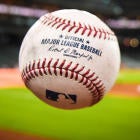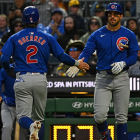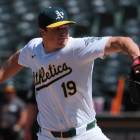On Wednesday, Major League Baseball released the results of its report regarding whether baseballs were "juiced" during recent MLB seasons. The league's study came following allegations that MLB deliberately altered baseballs in order to increase offense during the 2019 campaign. The report was conducted by a committee of outside experts, and focused on the performance of baseballs and the increased home run rates during the 2017 and 2019 seasons. There were 6,776 home runs hit in the 2019 MLB season -- by far the most of any year in league history.
The 27-page report ultimately concluded that the increase in home run rates in MLB can be attributed to the inconsistent baseball seam heights as well as players embracing launch angle. Ultimately, the league's baseballs appeared to be juiced because the seams were producing far less drag, the study said. The study concluded that the change wasn't intentional and was because of normal manufacturing variability.
"No evidence was found that changes in baseball performance were due to anything intentional on the part of Rawlings (the company that makes the league's official baseballs) or MLB and were likely due to manufacturing variability," the committee concluded in their report.
Here's an excerpt from the study:
"Analysis of StatCast data shows that the increase in home run rate between 2018 and 2019 was due in part to a change in launch conditions and in part to a change in the baseball drag. The increase due to changes in launch conditions was determined to be due to a change in player behavior rather than to changes in the baseball. ... The laboratory experiments, using newly developed techniques, show a correlation between drag and seam height, with the average seam height in 2019 smaller than that in 2018 by less than 0.001 inches."
This report is the second of its kind in the last two years. In May of 2018, the league revealed results of a study on whether juiced balls led to home run spike. In simple terms, the conclusion from that study found that the baseball was behaving differently when it is in the air.
There was a slowdown of home runs hit during the 2019 MLB postseason, leading some players and managers to question if the playoff balls had been un-juiced.
"We have never been asked to juice or de-juice a baseball," Rawlings president Michael Zlaket said at a Wednesday press conference.
There were indications the ball was not traveling as much as it did during the regular season, but the league denied it. "The only difference is the postseason stamp that is placed on the ball," the league said in a statement during the playoffs. The report analyzed the change, and noted that the comparison of regular to postseason games can't be viewed as equal since there are far fewer games played in the postseason. Regarding the postseason baseballs, here is what the report concluded:
"It is the understanding of the committee that Rawlings uses the same manufacturing process to create the baseball used in the postseason as they do to create the ball used in the regular season, save for the application of the postseason stamp. There would therefore be no reason to suspect a change in the performance properties of the baseball between the regular and postseason. ... The analysis of StatCast pitched ball trajectories indicates an increase in average drag in the 2019 postseason, leading to a decrease in both fly ball distances and home runs. The laboratory testing showed a comparable increase in drag but no change in seam height for the 2019 postseason baseballs compared to the 2019 regular season baseballs. Therefore, the reason for the change in drag for the postseason baseballs is not known."
The committee that conducted the 2019 study offered up possible remedies and quality-control measures as recommendations after the study. Those included developing a system to "track the dates on which balls are manufactured and shipped to clubs" and studying "the viability of employing humidors in all 30 parks to reduce the variability in storage conditions across the league."






















